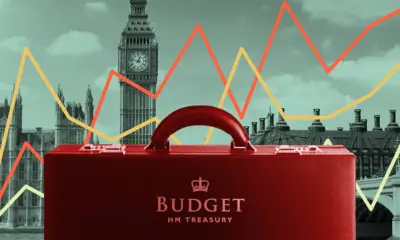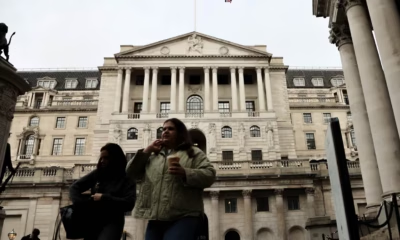Business
Investor Flows Move to Gilts and Gold as Equity Risk Rises

Introduction
Investors across the United Kingdom are rebalancing their portfolios toward safer assets as market volatility intensifies. Recent financial data indicate a marked increase in demand for UK government bonds, known as gilts, and for gold, reflecting a broad retreat from riskier equities. The shift signals growing caution among both institutional and retail investors who are responding to slowing economic growth, uncertain corporate earnings, and ongoing global instability.
This move toward defensive assets follows months of fluctuating equity prices and uneven economic indicators. Inflation remains above the Bank of England’s target, while consumer confidence and business sentiment continue to weaken. As a result, investors are prioritizing capital protection over aggressive returns. The renewed appetite for gilts and gold illustrates a clear turn toward safety in an uncertain environment shaped by tight monetary policy and geopolitical risk.
Surge in Demand for Gilts
UK gilt markets have seen strong inflows as investors seek predictable returns with minimal credit risk. Yields on two-year and five-year gilts remain near their highest levels in over a decade, offering income that rivals or exceeds many corporate bonds. For pension funds, insurers, and private investors, gilts have regained appeal as a source of stability.
The attraction lies not only in yield but also in expectations that the Bank of England may begin easing rates in 2025. Investors anticipate that a gradual reduction in interest rates would lift bond prices, providing additional capital gains. Foreign investors have also increased their purchases of sterling-denominated debt, encouraged by favorable yield differentials compared with eurozone bonds.
Analysts note that after a prolonged period of negative real returns during the low-rate era, gilts are once again delivering positive inflation-adjusted income. The market’s improved liquidity and transparent structure further enhance its status as a safe haven for both domestic and international investors.
Gold’s Safe-Haven Role Strengthens
Alongside bonds, gold has re-emerged as a preferred refuge amid rising uncertainty. Prices for the precious metal have climbed more than 10 percent over the past six months, supported by central bank buying and sustained retail demand. For many investors, gold’s value lies in its independence from financial systems and its proven resilience during times of inflation and market stress.
Exchange-traded funds backed by physical gold have reported consistent inflows since the start of the year. Institutional investors are using these vehicles to diversify portfolios and protect against potential declines in equity and currency markets. Physical gold purchases have also increased, with dealers across the UK citing higher sales of coins and small bars to private clients seeking tangible stores of wealth.
The correlation between gold and market confidence remains strong. Periods of political or economic tension typically coincide with increased investment in the metal. Analysts believe that as long as inflation expectations remain elevated and global risk persists, gold will continue to attract demand from cautious investors.
Equities Face Renewed Volatility
The shift into safe assets comes as equity markets experience renewed instability. The FTSE 100 and mid-cap indices have fluctuated sharply in recent weeks, reflecting investor unease about earnings growth and valuations. Corporate profits are under pressure from high input costs, slower consumer spending, and limited pricing power.
Retailers and property developers have been among the worst performers as higher borrowing costs and subdued demand weigh on revenues. Financial stocks have also faced headwinds, with concerns about loan defaults and slower mortgage growth affecting sentiment. Technology and energy shares, however, have shown more resilience due to strong global demand and long-term investment prospects.
Institutional investors are trimming exposure to cyclical sectors and focusing on companies with stable dividends and defensive balance sheets. Fund managers report increased client interest in capital preservation strategies, signaling a broader shift in investment behavior away from growth-oriented positions.
Macroeconomic Drivers
The cautious tone in financial markets reflects broader macroeconomic conditions. UK growth forecasts have been revised downward as household consumption slows and business investment remains weak. Although inflation has eased from its 2022 peak, it continues to limit spending power.
The Bank of England’s decision to maintain a restrictive policy stance is reinforcing the environment for high bond yields. Investors view this as both a risk and an opportunity. On one hand, elevated rates increase borrowing costs for companies and consumers. On the other, they create a favorable setting for fixed-income investments that offer real returns.
Global factors also play a role. Geopolitical tensions, fluctuating commodity prices, and slower growth in China have contributed to risk aversion. The resulting uncertainty has increased demand for traditional hedges such as gilts and gold while discouraging speculative investments.
Portfolio Adjustments and Strategy
Financial advisers are recommending a diversified approach that balances stability with selective exposure to growth. Many are advising clients to increase allocations to short and medium-term bonds while maintaining some equity positions in resilient sectors such as healthcare, utilities, and infrastructure.
For institutional investors, duration management and credit quality have become priorities. Pension funds are taking advantage of higher yields to lock in long-term liabilities. Meanwhile, wealth managers are encouraging clients to hold moderate positions in gold or commodity-linked assets as protection against inflation and market turbulence.
The overall shift represents a return to fundamentals. Investors are emphasizing liquidity, transparency, and predictable income streams rather than speculative growth. Portfolio construction now reflects an acceptance that volatility may remain elevated for some time.
Global Parallels
This trend extends beyond the UK. Investors worldwide are adopting a similar stance as global markets adjust to a new phase of slower growth and tighter financial conditions. In the United States, demand for Treasury securities has risen, while gold holdings among central banks have increased significantly. In Europe and Asia, funds have shifted toward high-quality sovereign bonds and commodity hedges.
The synchronized nature of this behavior indicates that the movement into defensive assets is not merely a temporary reaction but part of a broader structural adjustment. After more than a decade of easy monetary policy, investors are learning to navigate a world where money carries a cost and risk must be more carefully managed.
Conclusion
The movement of investor capital into gilts and gold marks a defining moment for the financial landscape. The shift underscores how higher rates, inflation uncertainty, and geopolitical risks have reshaped investment strategy across the United Kingdom. Investors are no longer chasing rapid returns but are instead seeking reliability, income, and preservation of wealth.
For policymakers, these trends highlight both confidence and caution. Strong demand for government bonds suggests faith in the country’s fiscal stability, yet it also reflects a subdued outlook for growth. The resurgence of gold investment indicates that many investors remain unconvinced that inflation has been fully contained.
In this environment, prudence dominates. Balanced portfolios that combine the safety of fixed income with selective exposure to equities and real assets are likely to define investment practice in the months ahead. Until greater clarity emerges about monetary policy and global stability, gilts and gold will remain central to the strategies of cautious investors navigating a complex financial landscape.




















